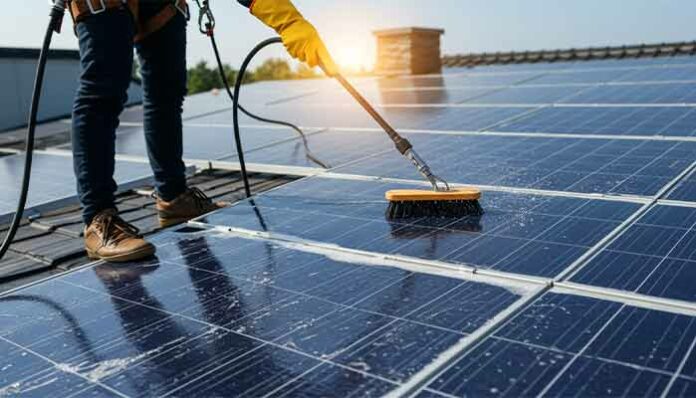Using solar panels is a smart step toward cleaner energy. They quietly turn sunlight into power, helping homes and offices run while keeping the environment safe. However, ensuring Safe Solar Panel Cleaning is vital for maintaining their efficiency and prolonging their lifespan.
If solar panels aren’t cleaned often, dust, dry leaves, and bird droppings can collect on them. This layer of dirt stops sunlight from reaching the panels properly, which can reduce their energy by as much as 25%. Giving them a gentle clean from time to time keeps them running well and helps you get full benefit from the sun. Safe Solar Panel Cleaning ensures the panels remain efficient and undamaged.
This guide gives you all the information you need—from the right tools and cleaning steps to safety tips, all recommended by experts. Whether you’re a homeowner or a professional, you’ll be able to clean your solar panels with ease and confidence. keeping them in top shape with Safe Solar Panel Cleaning techniques.
Key Cleaning Tools
Use a soft-bristled brush to clean solar panels without scratching. For rooftop panels, choose a long-handled brush to reach them easily.
A squeegee is the best tool to ensure your solar panels dry without any streaks, leaving them clean and smooth.
A regular garden hose with low pressure is ideal for rinsing your solar panels gently, ensuring they stay safe and undamaged.
A telescopic pole helps you reach solar panels that are high up or in hard-to-reach places with ease.
Using deionized or distilled water helps keep your solar panels free from mineral spots, making sure they stay clean and work well.
A mild dish soap is ideal for cleaning dust and grime from your Safe Solar Panel Cleaning while keeping their protective coating safe.
Mix equal parts of vinegar and water to easily remove tough stains from your solar panels and keep them clean.
Read More : While No One Noticed, the Pakistan Solar Shift Surprised the World
Protective Gear
Non-slip footwear and gloves – Helps you maintain a firm grip and protects your hands while working.
Harness for fall protection – Keeps you safe when you’re working on elevated rooftops.
Protective glasses and helmet – Shields your eyes and head from any potential hazards during cleaning.
Detailed Cleaning Guide
Getting Ready for the Cleaning
Choose a cooler day with clouds – This helps prevent quick drying, which can leave streaks on your solar panels.
Switch off the solar system – Always turn off the power to avoid any electrical hazards while cleaning.
Ensure safe access to your panels – Use a sturdy ladder or a telescopic pole to reach high panels securely.
First Step Rinse
Start by using a low-pressure hose to wash away any dust and loose debris. Begin at the top and move downward to avoid spreading dirt around.
With a low-pressure hose, gently rinse off dust and loose particles. Work from the top down to ensure dirt isn’t redistributed.
Surface Refreshing
Make the Cleaning Mix: In a clean container, mix soap with deionized water to create your cleaning solution.
Clean the Panel: Dip a soft-bristled brush into the solution and gently scrub the panel to remove dirt.
Handle Stubborn Marks: For tougher stains like bird droppings, let the solution sit for 1-2 minutes before lightly scrubbing to remove them.
Final Rinse and Drying Process
Thoroughly Rinse with Clean Water:
Ensure the surface is completely washed to remove any cleaning residue.
Use a Squeegee for a Spot-Free Finish:
Start from the top and work your way down for an even, streak-free result.
Air-Dry with Care:
If letting the surface air dry, ensure no hard water spots or residue are left behind for a flawless finish.
Cleaning Final Check
Check for Any Missed Spots or Imperfections:
Take a careful look to make sure there are no leftover spots, streaks, or any flaws that might have been missed.
Look for Loose Wires or Cracks in the Glass:
Make sure there are no loose wires or cracks in the glass that could cause any problems later.
Turn the System Back On and Monitor Its Performance:
Switch the system on again and observe how it’s running to ensure everything is functioning properly.
Safety Instructions
Guidelines for Electrical Safety
Always Ensure the System is Powered Off Before Cleaning:
Never clean the system while it’s still running to avoid any electrical hazards.
Keep Water Away from Sensitive Areas:
Avoid spraying water near junction boxes, inverters, or any exposed wiring to prevent damage or electrical risks.
Panel Safety Measures
Follow Manufacturer’s Instructions:
- Always refer to the manufacturer’s guidelines to ensure proper maintenance.
- Avoid Walking on the Panels or Using High-Pressure Washers:
- Do not step on the panels or use high-pressure washing, as both can cause damage.
- Use Only Approved Tools for Cleaning:
- Stick to recommended tools to avoid scratching or harming the panel surface.
- How Often Should You Clean Your Solar Panels?
- The cleaning frequency depends on environmental factors and the location of the panels.
Factors Influencing Cleaning Frequency:
Consider factors like dust, dirt, bird droppings, and weather conditions to determine how often your panels should be cleaned.
Climate Factors:
In areas where dust is common, such as deserts or coastal regions, your solar panels are more likely to collect dirt quickly and will need cleaning on a more regular basis.
Seasonal Changes:
During spring, pollen can build up on the panels, and winter snow can block sunlight, reducing efficiency. You may need to clean your panels more often in these seasons.
Panel Tilt:
If your solar panels are angled over 15°, rain can help wash away dirt naturally, making regular cleaning less necessary.
Panel Placement:
Solar panels located near factories, busy roads, or construction sites may gather dirt at a faster rate, so they might need cleaning more frequently.

